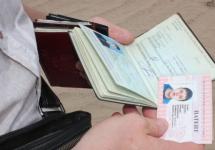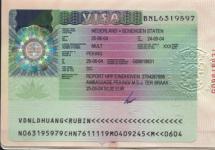The sample for filling out a Schengen visa for a child has its own characteristics. This process is slightly different from obtaining a permit to enter the Schengen area for an adult Russian citizen. First of all, for minor tourists from the Russian Federation, their parents/guardians fill out forms. In addition, a slightly different package of documents is submitted for young citizens. But in general, children have the right to visit almost equally with adults.
To visit the Schengen states, a Russian citizen must request the appropriate permit paper. Every person entering will need a Schengen visa, regardless of age. Even if parents travel with a newborn child, a separate visa is opened for him. The entry about a son or daughter in the parent’s passport does not matter either - a Schengen visa is requested for such children as well.
In fact, a Schengen visa received by a minor is no different from a similar document for an adult. A person’s age plays a role only when filling out the questionnaire. For children, all required data is entered by their official representatives - parents or guardians. In addition, a child under 12 years of age will not be required to provide fingerprints for a visa.
Otherwise, the process of obtaining an entry document is the same:
- Take a standard 4-page one for free (download from our website, ask at the embassy/consulate or visa center). If applicable, information in the application is entered online via the Internet. But in any case, the application must be completed by the parent/guardian of the young citizen. It is important to remember that a separate application for the child is submitted in any case. Even if the young tourist is included in the parent’s passport.

- Collect documents required for the specific purpose of staying in the Schengen area. The basic “children’s” package for a tourist trip includes:
- Child's international passport. If a minor is included in the parent’s passport, additional blank pages should be left in the passport (minimum 2 pages per child).
- Birth certificate. Children over 14 years of age apply for a Russian passport.
- 2 photographs 35 by 45 mm.
- Certificate from the educational institution (for schoolchildren and students).
- Confirmation of the availability of accommodation for the entire duration of the tour (hotel reservation, rental agreement, etc.). As a rule, a document is required even if the child will live in the same hotel room with the parents.
- . Plus, a copy of the first page of the sponsor's passport and his financial guarantees (certificate from the employer, etc.) are attached.
- Consent of the parents/parent to the child’s departure (if the young traveler travels alone, with one of the parents or with someone else).
- Open Schengen of parents/parent (if a small citizen makes a trip with his parents/parent, but his Schengen visa was requested later).
- Medical insurance coverage from 30 thousand euros (valid throughout Schengen for the entire train).
- Consent to the processing of personal information (if documentation is submitted at the visa center).

- Submit the child’s Schengen visa application and other documents to the diplomatic mission:
- Directly to the embassy/consulate.
- Through the visa center.
- Through an accredited travel agency (if applicable).
- Pay visa fees: consular (35 euros) and service fees when applying at the visa center (15–20 euros). Children under 6 years old are exempt from both fees.
- Wait for a response to your request. It usually takes 5-10 business days for the case to be processed.

Subtleties of filling out the questionnaire
The sample for filling out a Schengen visa for a child is almost the same as for an adult. The main nuances of the process of entering information into a visa application:

- You should take a form from the country where the minor guest will stay for most of the visit. If the voyage covers several countries with equal duration of stay, the form of the questionnaire of the country of first entry is selected.
- Each state of the Schengen area offers questionnaire forms with questions translated into Russian. But few allow answering in Russian (for example, Poland and Estonia).
- Most Schengen countries require that the application be completed either in English or in the official language of the country of primary residence or first entry. A number of diplomatic departments allow the use of transliteration (Russian words are written in Latin). However, in points No. 1–5, answers are always indicated in Latin letters, as in a foreign passport. Even if other questions are allowed to be answered in Russian.
- Typically, the form is filled out on a computer or by hand (with a pen with black or blue ink).
- When filling out by hand, the words are written legibly and clearly - in block letters.
- In case of any error, it is not recommended to make corrections. It is better to retype or rewrite the application.

Online forms
Some diplomatic missions offer online applications for visa candidates. To fill out, go to the official website and register. Then you need to answer the same questions as in the standard questionnaire. For example, Germany only accepts applications completed online.
As a rule, time to complete electronic applications is limited. If you don't meet the deadline, you'll have to start all over again. After entering the data, the application is printed, signed and submitted with other documentation.
Filling out a visa application
How to answer questionnaire questions correctly if a Schengen visa is requested for a child? Let's figure it out point by point.
| Items | Sample answers |
|---|---|
| 1 | The surname is indicated as it is written in the passport (IVANOV) |
| 2 | To be filled in if the child’s current surname differs from that given at birth (SIDOROV) |
| 3 | Name as in the international passport (IVAN) |
| 4 | Day, month and year of birth (19-04-2009) |
| 5 | Name of the city/village where the young Russian was born (MOSCOW) |
| 6 | Write country of birth (RUSSIAN FEDERATION) |
| 7 | Citizenship is being clarified (RUSSIAN FEDERATION) |
| 8 | The gender of the child is indicated |
| 9 | Information about the child’s marital status (“single/unmarried”) is entered. |
| 10 | This item must be completed only when submitting an application for a child. Basic details of the parent/guardian should be provided:
|
| 11 | This item is unlikely to need to be filled out in the “children’s” application form, since the TIN or Russian passport number is recorded here |
| 12 | Passport with which the child will enter Schengen:
|
| 13–16 | Basic information is copied from the child’s international passport or parent’s passport:
|
| 17 | Child's address. Additionally, indicate the email and telephone number of the parent or the child himself:
|
| 18 | The country of citizenship of the young traveler is written if it differs from the country of current stay |
| 19 | The paragraph on professional activity is skipped if the application is written for an infant or kindergartener. For a school student indicate PUPIL, for a college or university student - STUDENT |
| 20 | For schoolchildren and students, write the name and address of the place of study |
| 21 | The main purpose of coming to Europe is being clarified |
| 22 | Schengen powers selected for visit |
| 23 | Country of first entry |
| 24 | Type of visa – single, double or multiple entry |
| 25 | Duration of visit. If a parent wants to obtain a multi-visa for a child, the maximum duration of stay is indicated (90 days) |
| 26 | To be filled out if the child has already had visas from Schengen states over the past 3 years |
| 27 | Fingerprint information is written. Let us remind you that children under 12 years of age are exempt from fingerprinting. |
| 28 | The item about the country of destination is filled in during a transit trip |
| 29–30 | Dates of arrival and departure from Schengen. If a multi-visa is selected, the duration of the expected stay is written |
| 31 | Name or coordinates of place of residence. Additionally, write the address, e-mail and telephone number of the hotel or host |
| 32 | Host organization details. The column is filled in if the child is going, for example, for short-term study. Then indicate the name and contacts of the educational institution |
| 33 | Who bears the costs of travel and accommodation for the child. As an example, the “Other” option is selected with the explanation that these are parents |
| 34–35 | The fields are filled in by relatives of EU citizens |
| 36 | Place, day, month and year of filling out the application (MOSCOW, 03/16/2017) |
Who signs the application
In paragraph No. 37, the parent/guardian who filled out the form signs. The adult puts another signature at the very end of the application (4th sheet). Some diplomatic missions (for example, Austrian) require the signatures of both parents. And the Czech Republic and the same Austria ask children over 14 and under 18 to put a personal signature next to their parent’s. Young people over 18 years of age sign themselves in any case.

The third signature of the parent/guardian must be placed in the non-refundable visa fee column (under item No. 37). If a multiple visa is requested, a fourth signature is required - in the section on medical insurance (under item No. 37 and the column on the visa fee).
It is recommended to print the completed application form using double-sided printing. A number of diplomatic missions require only this type of printing. For printing, regular A4 size copier sheets are used. It is desirable that it be high-quality thick paper.



